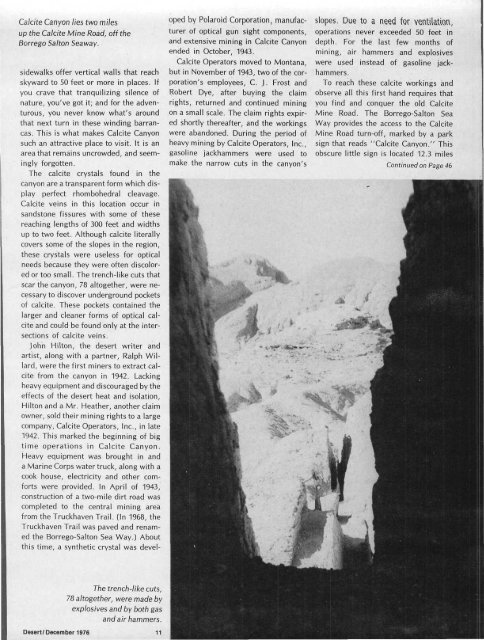1 - Desert Magazine of the Southwest
1 - Desert Magazine of the Southwest
1 - Desert Magazine of the Southwest
You also want an ePaper? Increase the reach of your titles
YUMPU automatically turns print PDFs into web optimized ePapers that Google loves.
Calcite Canyon lies two miles<br />
up <strong>the</strong> Calcite Mine Road, <strong>of</strong>f <strong>the</strong><br />
Borrego Salton Seaway.<br />
sidewalks <strong>of</strong>fer vertical walls that reach<br />
skyward to 50 feet or more in places. If<br />
you crave that tranquilizing silence <strong>of</strong><br />
nature, you've got it; and for <strong>the</strong> adventurous,<br />
you never know what's around<br />
that next turn in <strong>the</strong>se winding barrancas.<br />
This is what makes Calcite Canyon<br />
such an attractive place to visit. It is an<br />
area that remains uncrowded, and seemingly<br />
forgotten.<br />
The calcite crystals found in <strong>the</strong><br />
canyon are a transparent form which display<br />
perfect rhombohedral cleavage.<br />
Calcite veins in this location occur in<br />
sandstone fissures with some <strong>of</strong> <strong>the</strong>se<br />
reaching lengths <strong>of</strong> 300 feet and widths<br />
up to two feet. Although calcite literally<br />
covers some <strong>of</strong> <strong>the</strong> slopes in <strong>the</strong> region,<br />
<strong>the</strong>se crystals were useless for optical<br />
needs because <strong>the</strong>y were <strong>of</strong>ten discolored<br />
or too small. The trench-like cuts that<br />
scar <strong>the</strong> canyon, 78 altoge<strong>the</strong>r, were necessary<br />
to discover underground pockets<br />
<strong>of</strong> calcite. These pockets contained <strong>the</strong><br />
larger and cleaner forms <strong>of</strong> optical calcite<br />
and could be found only at <strong>the</strong> intersections<br />
<strong>of</strong> calcite veins.<br />
John Hilton, <strong>the</strong> desert writer and<br />
artist, along with a partner, Ralph Willard,<br />
were <strong>the</strong> first miners to extract calcite<br />
from <strong>the</strong> canyon in 1942. Lacking<br />
heavy equipment and discouraged by <strong>the</strong><br />
effects <strong>of</strong> <strong>the</strong> desert heat and isolation,<br />
Hilton and a Mr. Hea<strong>the</strong>r, ano<strong>the</strong>r claim<br />
owner, sold <strong>the</strong>ir mining rights to a large<br />
company, Calcite Operators, Inc., in late<br />
1942. This marked <strong>the</strong> beginning <strong>of</strong> big<br />
time operations in Calcite Canyon.<br />
Heavy equipment was brought in and<br />
a Marine Corps water truck, along with a<br />
cook house, electricity and o<strong>the</strong>r comforts<br />
were provided. In April <strong>of</strong> 1943,<br />
construction <strong>of</strong> a two-mile dirt road was<br />
completed to <strong>the</strong> central mining area<br />
from <strong>the</strong> Truckhaven Trail. (In 1968, <strong>the</strong><br />
Truckhaven Trail was paved and renamed<br />
<strong>the</strong> Borrego-Salton Sea Way.) About<br />
this time, a syn<strong>the</strong>tic crystal was devel-<br />
The trench-like cuts,<br />
78 altoge<strong>the</strong>r, were made by<br />
explosives and by both gas<br />
and air hammers.<br />
<strong>Desert</strong>/December 1976 11<br />
oped by Polaroid Corporation, manufacturer<br />
<strong>of</strong> optical gun sight components,<br />
and extensive mining in Calcite Canyon<br />
ended in October, 1943.<br />
Calcite Operators moved to Montana,<br />
but in November <strong>of</strong> 1943, two <strong>of</strong> <strong>the</strong> corporation's<br />
employees, C. J. Frost and<br />
Robert Dye, after buying <strong>the</strong> claim<br />
rights, returned and continued mining<br />
on a small scale. The claim rights expired<br />
shortly <strong>the</strong>reafter, and <strong>the</strong> workings<br />
were abandoned. During <strong>the</strong> period <strong>of</strong><br />
heavy mining by Calcite Operators, Inc.,<br />
gasoline jackhammers were used to<br />
make <strong>the</strong> narrow cuts in <strong>the</strong> canyon's<br />
slopes. Due to a need for ventilation,<br />
operations never exceeded 50 feet in<br />
depth. For <strong>the</strong> last few months <strong>of</strong><br />
mining, air hammers and explosives<br />
were used instead <strong>of</strong> gasoline jackhammers.<br />
To reach <strong>the</strong>se calcite workings and<br />
observe all this first hand requires that<br />
you find and conquer <strong>the</strong> old Calcite<br />
Mine Road. The Borrego-Salton Sea<br />
Way provides <strong>the</strong> access to <strong>the</strong> Calcite<br />
Mine Road turn-<strong>of</strong>f, marked by a park<br />
sign that reads "Calcite Canyon." This<br />
obscure little sign is located 12.3 miles<br />
Continued on Page 46

















